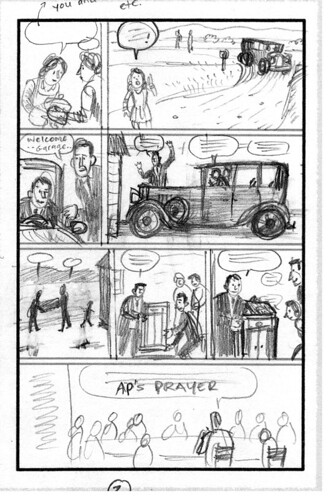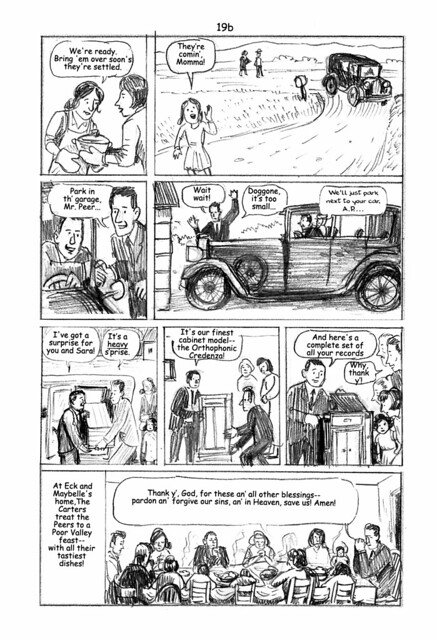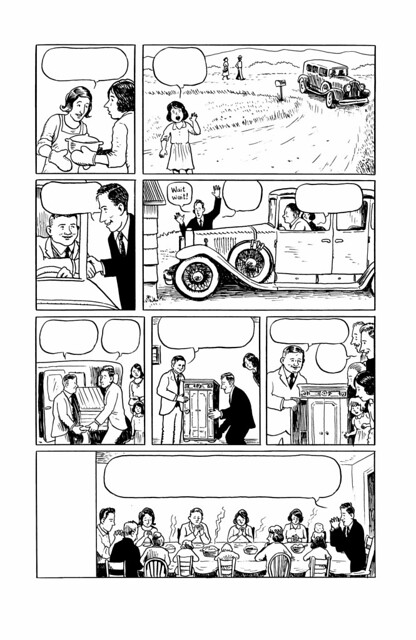Frank and I wanted to show you what went into creating an average page of our Carter Family graphic novel. I chose the page in which their producer and manager, Ralph Peer, along with his wife Anita, arrives on a visit to the Carters in Maces Spring, VA.
The text here, is by Frank, unless I pipe in (with blue type)...
-David
The process of creating comics is highly subjective. Some artists just put pen
or pencil to paper and move forward, without a clear idea where they're going.
Others out-do Alfred Hitchcock in the pre-planning stages, and create multiple
images of each panel before they commit the final image to paper.
Add a
writer to the mix, and their style of input also affects the creative outcome.
Every cartoonist or creative team has their own method. And a method
of some kind is a must--especially when creating a long-form work. Our agent,
Bob Mecoy, has called our graphic novel a "movie on paper," and some of the
methodology of film-making did influence our approach.
Here is the origin
of one page from our book, from rough script to thumbnails to pencil and ink to
publication.
The script, at this point, is more of a guidepost of the
marks we want to hit in each panel. There's no for-real dialogue--just detailed
descriptions of each panel's event, mood and what each character is doing or
feeling. Nothing is cast in stone here. In this case, the finished page is
pretty close to the descriptions in the script.
The only piece of
dialogue that stayed to the end is A.P.'s blessing for the meal, in the last
panel of the page. That was a documented piece of real-life speech.
Next
is the first rough thumbnail. This is a vital stage. Will the sequence work in
comics form? Does the panel-to-panel flow make sense, and support the events and
the characters? Frank did this first thumbnail. It won't win an art contest;
it's only meant to serve the material.
(Note: The 'thumbnail' images are only about 3 inches tall. Just enough to get a sense of what will fit on the page, without getting bogged down in details.)
Next, David took this first rough thumbnail
and revised it. Notice that he cuts out a panel and adds another. This was a
good decision. His sketches are tighter than the first thumbnail, but still more
suggestive than definitive.
(We wanted to highlight the fact that the Ralph Peer's Cadillac is large -- too large for the garage A.P. has built in anticipation of the visit. We've also added a panel to the presentation of the Orthophonic Credenza, an important gift from Peer to the Carters.)
In the next iteration, (a pencil rough drawn at print size) David tightens up the
staging of the panels, the body language of each character, and gives a strong
sense of the settings. Frank then enters the first draft of the dialogue.
Then, it's decided that a long-shot could be made more effective as a
medium shot (in panel 5). At this point, the page is ready to commit to ink on
paper.
(We showed the rough draft of our book to an artist who is very experienced with this kind of material, and he advised me to draw Ralph Peer's Cadillac Limo much larger. On this page I digitally enlarged the Cadillac in every panel, and made Peer higher in the driver's seat, in panel 3. We also decided to add more family members to the table in the last panel.)
As David inks the final version, he tightens up the compositions
and figures. This piece of the story really and truly comes to life.
(I should note that we had to find reference photos for the Cadillac Limo and the Orthophonic Credenza. Extra time, but worth it for historical accuracy.)
Now it's ready for Frank to color. After that, the final dialogue is written. There are some small changes from the first draft of the dialogue and narration--mostly in reducing the amount of text.
As said, this page did
not undergo a major change from start to finish--just a refinement of the
narrative event that its eight panels capture.
(I hope what comes across is that a great amount of care went into making every page of this book. Frank and I gave this our all.)
If anyone would like to see larger versions of the images above, they are all available on flickr.com: http://www.flickr.com/photos/dlasky/tags/dftspageevolution/
Subscribe to:
Post Comments (Atom)











No comments:
Post a Comment